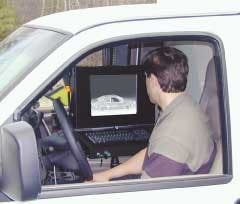X-ray systems enhance security
VSD:How is American Science and Engineering using imaging? Which applications are becoming more or less important?
Baukus: AS&E uses imaging to display the results of x-ray scans to operators and evaluators for security-oriented inspection of parcels, personnel, and cargo. The systems also perform nondestructive inspection of items such as automobiles, aircraft, and spacecraft. We use a combination of both transmission and backscatter x-ray imaging to produce images that assist operators in finding potential threats, and we use backscatter-only imaging to produce photo-like images in applications where access is restricted to one side of the object.
Security-oriented applications employing the combination of high-energy, high-resolution transmission imaging coupled with backscatter imaging—which highlights organic objects—has become increasingly important since 9/11.
VSD:What changes in the security market are driving these applications?
Baukus: As the security market becomes increasingly involved with examining high-density cargo in the maritime arena and air cargo, as well, it's critical to produce high-resolution images that give the inspectors the best possible chance of finding threats and contraband. AS&E's Shaped Energy systems use 3.8-MeV transmission x-rays to produce a high-penetration, high-resolution image and supplement it with 225-keV backscatter images from both sides of the cargo. All images are created simultaneously. Our systems' ability to highlight organic materials including explosives, drugs, and people using backscatter images is key. In addition, these systems can sense radioactivity indicative of a dirty bomb or a nuclear device at the same time that they are producing x-ray images. The displays convey all of this information [see figure].
From the cab of an AS&E Z-backscatter van, the operator can scan a line of stopped cars for hidden material using an x-ray backscatter imaging technique. The display produces real-time images and is readable in sunlight. Mounted on a swivel, the driver or a passenger can examine the image.
VSD:Within each application area, what are the most important performance criteria when qualifying a system?
Backus: In all application areas, we believe that detectability—the ability of an x-ray inspection system to present to its operator sufficient information to identify objects of interest—is the most important criterion. Factors that feed detectability include image resolution, contrast sensitivity, and the user friendliness of the display system software, which enables the operator to easily manipulate the image data.
VSD:What technologies and components does AS&E use in these applications?
Baukus: We use x-ray tubes for x-rays up to 450 keV and linear accelerators for high-energy x-rays. We also use high-efficiency scintillator-based detector modules and segmented detector arrays. To process and present the images, we use high-speed computers and image-processing software, along with customized image-manipulation software
VSD:How does AS&E approach a new application? Does your lab qualify, design, build, or RFP the imaging systems that you sell?
Baukus: Our approach to developing a new application starts with creating an internal program-requirements document that defines the application, the proposed system, and initial specifications. This document is refined and upgraded throughout the project. We maintain a list of vendors through our sourcing department and constantly review the industry for qualified sources.
AS&E engineers and manufactures a majority of the pieces and parts of the systems we develop and sell, but we also subcontract portions of our systems to qualified vendors. For example, we manufacture our own linear accelerators for producing high-energy x-rays, but we purchase lower-energy x-ray tubes.
VSD:Does AS&E perform its own systems integration or look to outside integrators for support? If so, what criteria do you look for when selecting an integrator?
Baukus: For its self-contained systems, AS&E performs its own integration of the pieces and parts that make up the product. For the fixed-site installations that involve interface with local infrastructure, and/or the construction of buildings or transport mechanisms, we will often employ contractors who are familiar with the location and have the required expertise. In a wider sense, AS&E will work with overall system integrators who might be charged with installing a complete security system that involves fences, cameras, and other sensors. In all cases, we will research the potential integrator's performance record and also rely on our previous experiences with a particular company before making a selection.
VSD:How do you envision the future of imaging and x-ray technology in security and industry? What kinds of new applications do you expect to emerge?
Baukus: We see x-ray imaging systems having a place in both security and industrial nonintrusive inspection for some time to come. There is and will continue to be a place for both commodity systems that might be used to inspect parcels in airports or lobbies of buildings, for example, and for customized systems that must be adapted to meet unique needs and circumstances. Nonintrusive inspection systems, as well as fixed-site security systems, usually fall into this latter category.
Relative to new applications, as security needs continue to increase, there may be more call for systems that incorporate and integrate the display of several types of sensors for evaluation by an inspector or operator.
VSD:How will x-ray imaging systems have to change to successfully meet these emerging applications?
Baukus: Inspection systems are becoming more and more complex. As the operators and inspectors using this equipment are presented with increasingly busy images, it may be necessary to introduce operator-assist features that can help interpret the data and/or highlights areas of specific interest. Automatic systems that can identify an anomalous condition—be it a threat or a defective part—are currently limited in their use and effectiveness and can exhibit unacceptably high false alarms. Smarter systems are needed and are being developed, but it also requires a smart user to know how best to deploy and employ such devices.
WILLIAM BAUKUS is director of technical marketing for American Science and Engineering (AS&E; Billerica, MA, USA). He has a BS and MS in electrical engineering from the University of Connecticut (Storrs-Manfield, CT, USA) and has worked in technical and business-development positions at Sanders (now BAE Systems; Nashua, NH, USA), MITRE (Bedford, MA, USA), and in the US Air Force. Editor in chief Conard Holton talked to him about x-ray security systems and emerging applications.


